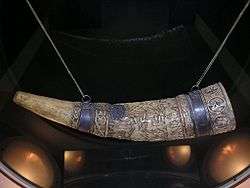Blowing horn
The blowing horn or winding horn is a sound device that is usually made of or shaped like an animal horn, arranged to blow from a hole in the pointed end of it. This rudimentary device had a variety of functions in many cultures, in most cases reducing its scope to exhibiting, celebratory or group identification purposes (signal instrument). On the other hand, it has kept its function and profile in many cattle raising, agricultural and hunter-gatherer societies.

Types

The oldest varieties were made of wood and animal horns (usually ovis and Bovidae). The earliest findings in Europe are Bronze Age metal horns, the strength of which resulted in its better endurance of the rigours of time. As a result, previous traces of other materials have vanished, so the oldest surviving animal horn dates back to the Late Iron Age in Visnum, Sweden.[1] As big horned animals are rarely found in Scandinavia, blowing horns are often made from wood, wound birch bark or bout, called a "lur".
Uses
Many horns have been used as sounding cries by ancient societies. A modern day descendant of the horn, the bugle, is used to call out orders in military camps. The hunting horn was used to communicate on a hunt and is still used today in some places.
In Biscay, territory of the Basque Country, following an old tradition, a practice is being restored to blow the horn from five mountains in the province once a year. These mountains, namely Gorbea (4,859 ft.), Sollube (2,251 ft), Oiz (3,376 ft.), Ganekogorta (3,274 ft) and Kolitza (2,884 ft) are dubbed the montes bocineros, meaning the 'hornblower mounts'. According to historic evidence, up to the late 16th century the Biscayne were summoned to the General Council of the Domain of Biscay to be held in the town of Gernika by playing horns from the summits.
A like function may be attributed to the pututu, the sound instrument from the Andes. The device, usually made of a shell or hollowed out cow horn, is used to summon people to a meeting or a festival. In the Inca period, the messengers spreading throughout Empire known as chaski carried along a pututu, which was blown to herald their arrival to a particular place.
In the United States, it is common for a traditional horn to be blown to signify the serving of a buffet. This is a typical lunch time tradition in Kentucky.[2]
Cheap plastic vuvuzelas achieved fame and controversy in the hands of football supporters during the 2010 World Cup in South Africa.
Religion
One of the more widespread uses for blowing horns today is the shofar, a ram or Kudu horn with a hole drilled through it. The shofar is used mainly for Jewish ceremonies such as Rosh Hashana. Horns are sometimes used in the other two abrahamic religions also.
Similarly, the dungchen is a ritual horn used in Tibetan Buddhism. In modern Paganism the blowing horn is used to call the Horned God.
An angel (Moroni) blowing a horn as a warning voice is an unofficial symbol used frequently by the Church of Jesus Christ of Latter-day Saints (frequently referred to by others as "Mormons"). A statue of the Angel Moroni sits atop the main spire of most of the sacred temples belonging to this church.
See also
- The shells of some very large sea snails are modified by humans so that they can be blown like a horn, see Conch (musical instrument).
- Drinking horn
References
- "Blowing horns". Ancient Music. Retrieved 2008-01-29.
- "Calling Lunch" (PDF). Kentucky Nutrition Council. Retrieved 2012-07-13.
http://www.nwhsa.org.uk/horn.html Hunting calls for fox & deer
External links
- Educational web page on the Basque hornblower mountains Article in Spanish